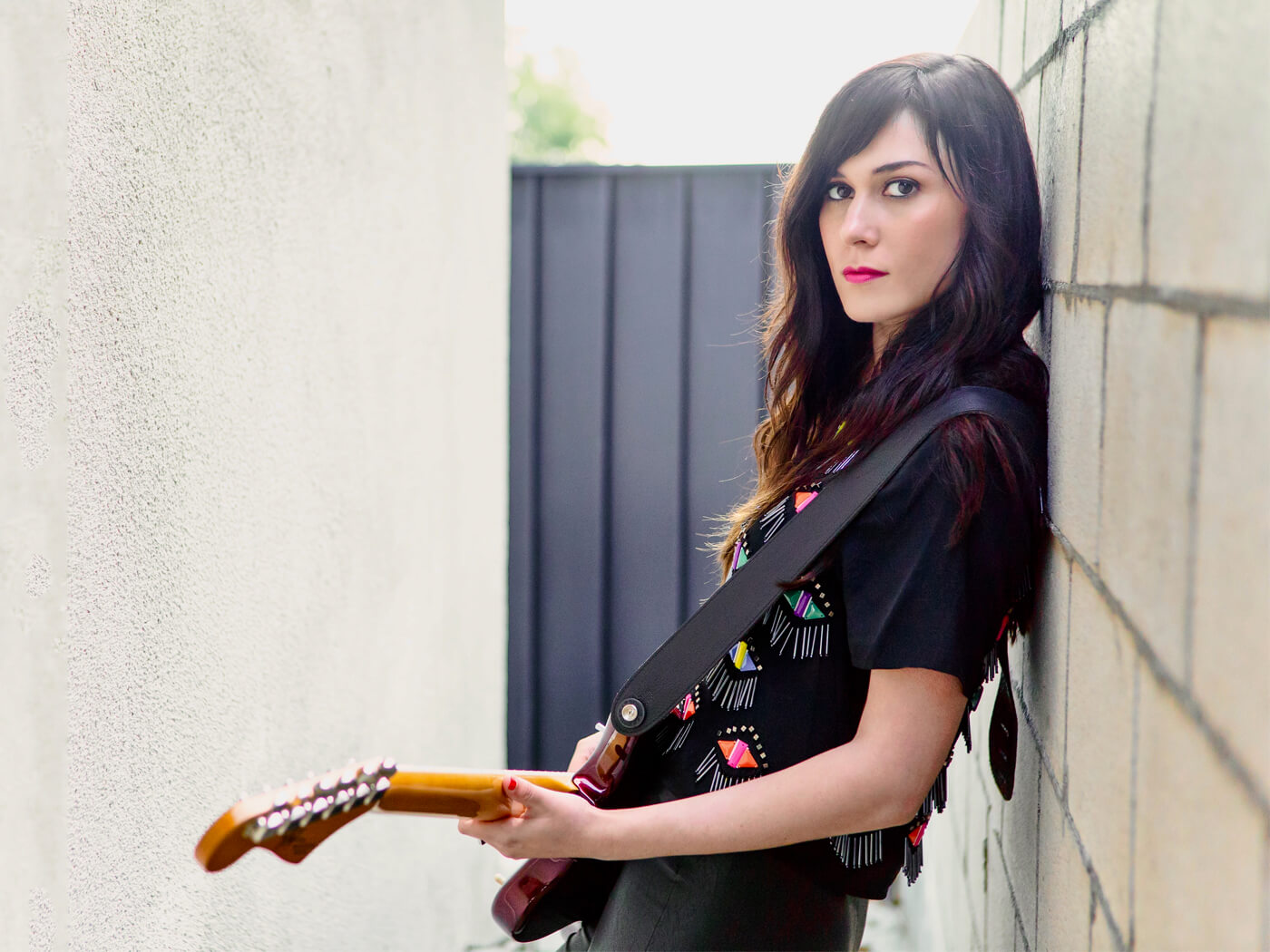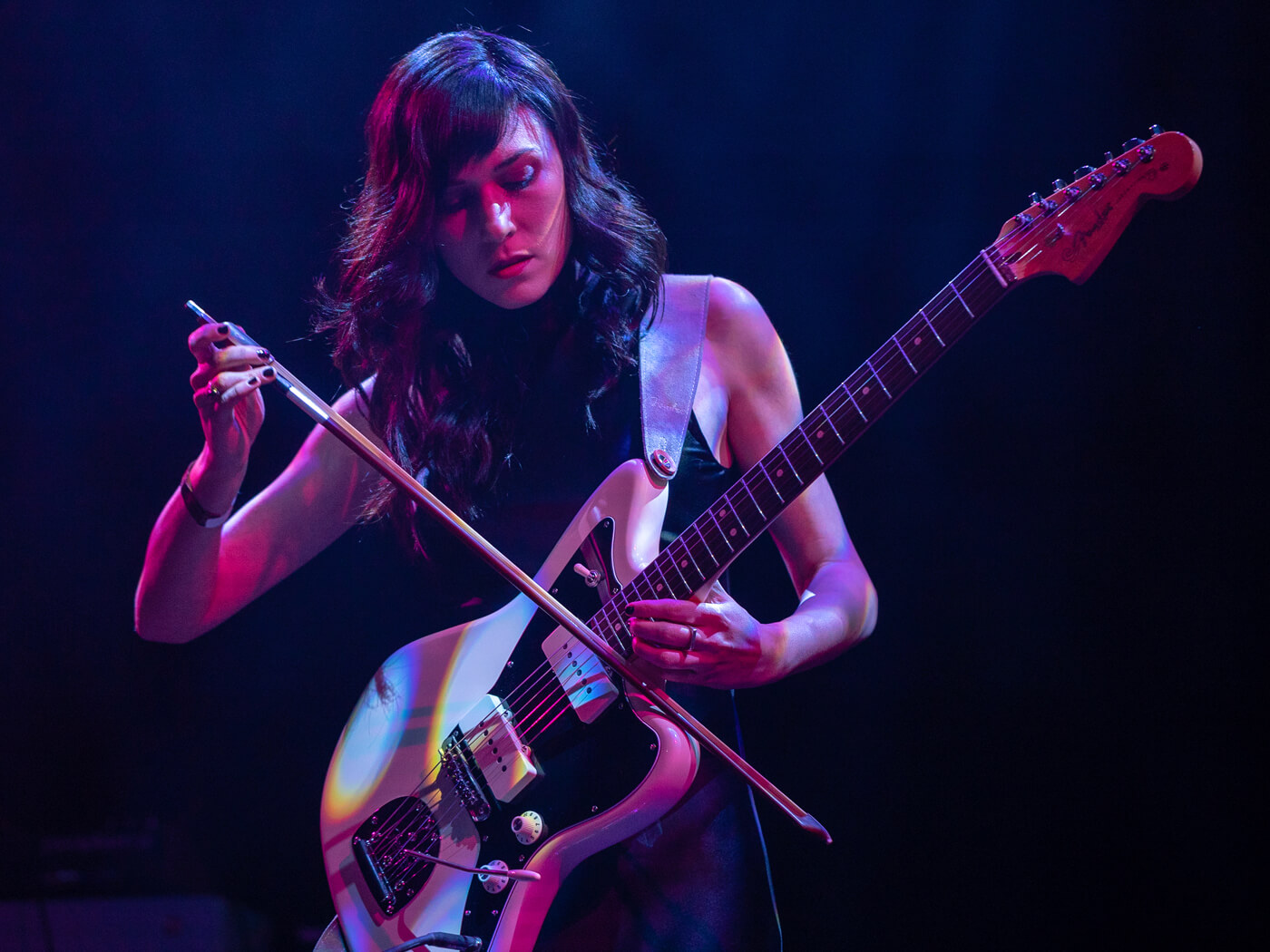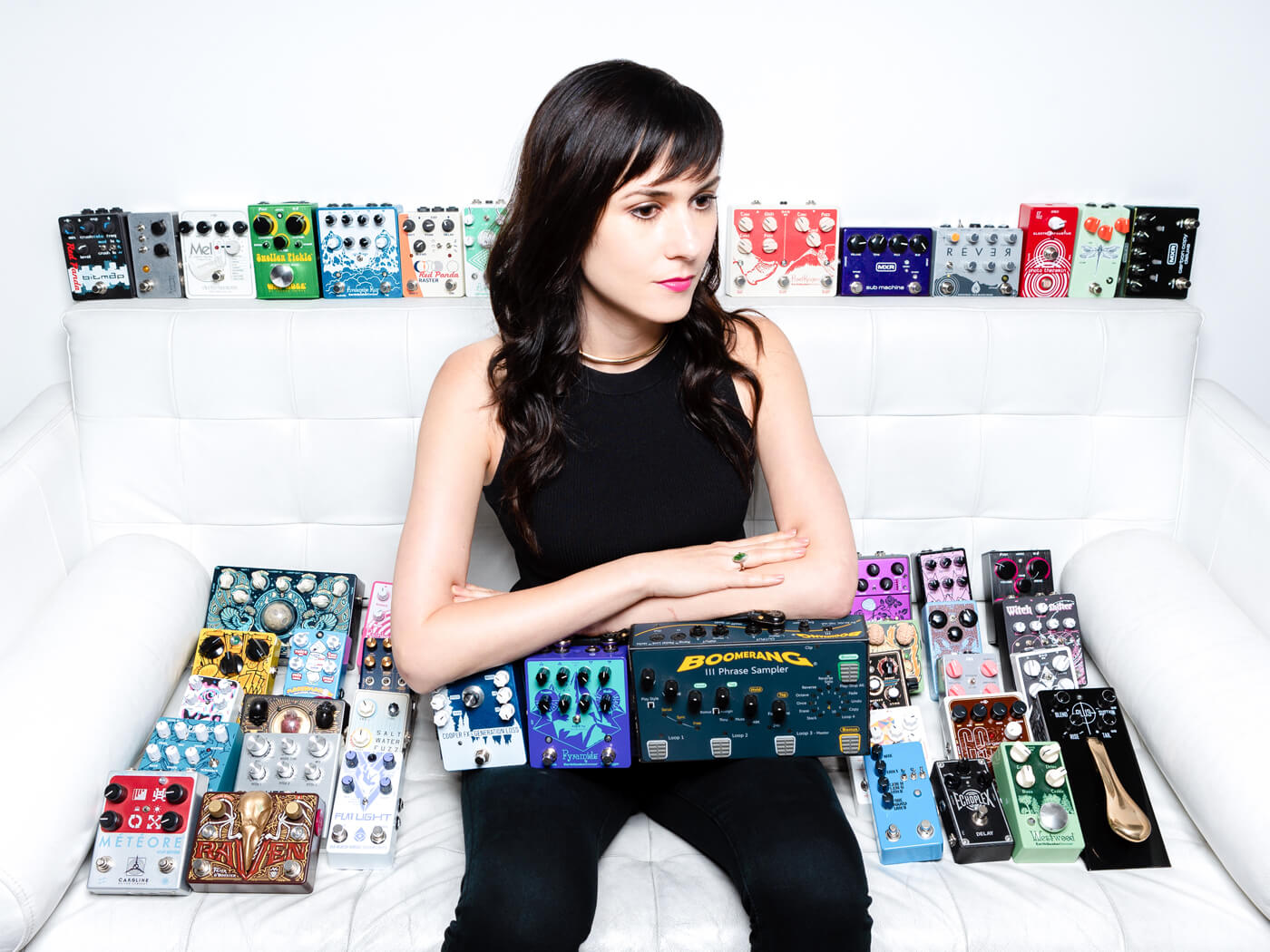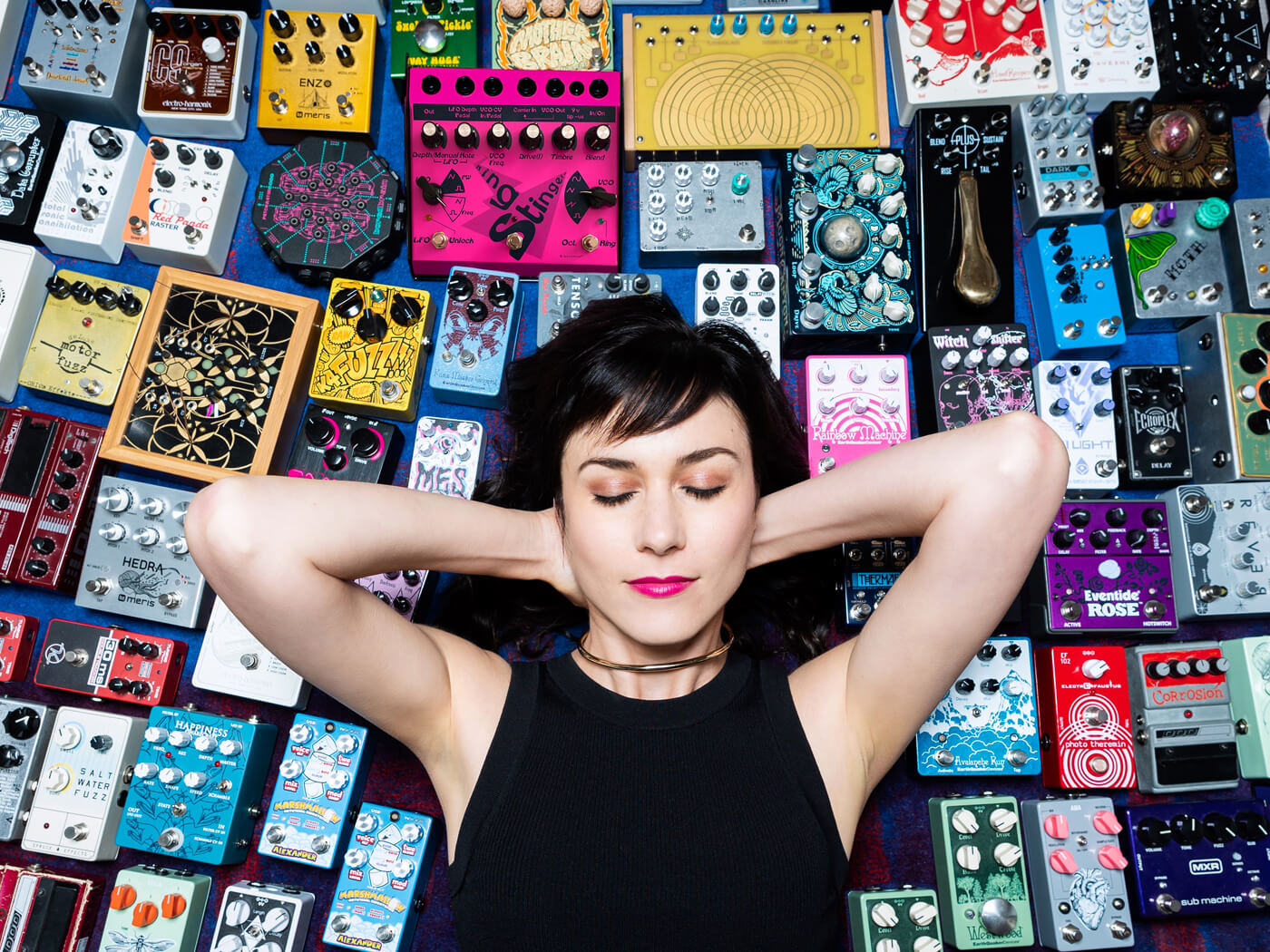Sarah Lipstate aka Noveller brings her moody soundscapes to Iggy Pop’s new album
The Los Angeles-based instrumentalist talks the process behind Pop’s new record, putting together the perfect pedalboard and pushing the boundaries of what a guitar can do.

Image: Priscilla C. Scott
When Sarah Lipstate was 16, she got a summer job just so she could buy her first guitar – a Danelectro. Now, 14 years later, she’s crafted a signature sound as her experimental solo project Noveller. Constantly pushing her electric six-string sound into unfamiliar territory, Lipstate is known for her transcendental compositions, products of innovative playing techniques and a smorgasbord of pedals.
Her penchant for creating such ambient soundscapes attracted the attention of many, including the Godfather of Punk himself, Iggy Pop. In 2016, Pop invited Noveller to open for him during the Post Pop Depression tour. Only three years later, she is one of Pop’s featured collaborators on his uniquely somber new album, Free. Bookending the release with three of her compositions, Noveller helped the punk icon explore a new sonic direction.
Before the record’s release on 6 September, Noveller sat down with Guitar.com to talk about working with the rock legend, choosing the right pedals and pushing her live show to the next level.

You didn’t grow up in a musical household, so how did your relationship with the guitar start?
I wasn’t raised in a musical household but my parents put me into piano lessons when I was young, so I guess they wanted me to have some kind of musical education. And they also told me that I needed to join the band in middle school and high school, so I played the trombone in that. Guitar came later. I think when I was around 16, I started telling my parents that I wanted to learn how to play it but they didn’t really get excited about that. I had to get a summer job and save up money and buy my own first electric guitar.
Around that time, I started getting really into bands like Sonic Youth. I think that’s what got me really excited about starting to figure out how to play. It was definitely something that I had to fight for a little bit, so I just worked a crappy summer job and was able to buy the cheapest guitar in the store. It was a Danelectro in a periwinkle blue colour. They gave me an extra discount because they said no one wanted the guitar in that colour. I still have it! I bought a Fender suede guitar strap which I still use and I bought the Danelectro Dirty Thirty practice amplifier which I still have and still use also.
Was there a moment when you decided that you were going to be experimental in your approach to playing?
That was pretty much from the beginning. I knew that Sonic Youth used alternate tunings and I thought that was really amazing. I kind of just took inspiration from that, so what I would do is just tune the strings until it sounded interesting and strumming it open. Then I would start writing my own songs in whatever tuning that happened to be. At that point in my life, I had just gotten really tired of being in a musical environment where the focus was about being technically the best. With the guitar, I didn’t want anyone to tell me how to play it. I only started playing in standard tuning in 2017.
Is there a specific model or make that you steer towards, or does it depend on what you’re working on?
I’ve bought a lot of guitars since I was 17. I found that the Fender Jazzmaster is really where I feel at home. My main guitar at the moment is the American Professional Series Jazzmaster and what I really like about it is that they gave the neck 22 frets. I do a lot of playing up high, I do a lot of bowing up high and having so many frets is amazing. So I’m kind of stuck on that Jazzmaster.

When did you start bowing guitars, was that from the beginning too?
So that was pretty early on when I was in college, around 2004. Luckily I moved from Louisiana to Austin, Texas – it’s a big music city so there were a lot of guitar shops and a lot of places to go and buy musical accessories. I was at a guitar shop, I think it was Austin Vintage Guitars, but they had a violin bow there in the store and so I just picked it up and started bowing the guitar with it. I figured that if it was at a guitar shop, I could use it with my guitar. It’s a technique of playing that’s just really resonated with me. I use it on all of my albums.
What was it like to collaborate with Iggy Pop on his new album?
It was amazing. Iggy is based in Miami and I’m based in Los Angeles, so it was the perfect digital age collaboration. I was sent the vocal track and they said, “Do what you do”. I was able to compose and record my soundscapes at my home studio and just email it over to them, and it was as easy as that.
Was there a specific sonic direction that you both had in mind?
The first piece that Iggy sent me was his vocal for Do Not Go Gentle Into That Good Night and I really just went on instinct. I really wanted to support the vocal and create a narrative, emotional arc with my playing. I had previously recorded an all-guitar cover of the theme from John Carpenter’s The Thing and Iggy had heard that and he really, really liked that.
So he said, “I was wondering if you could listen to this vocal piece for The Dawn and do something inspired by the John Carpenter cover for it.” I started out with a pulse, like a heartbeat and then just composed all the guitar lines around that. The way that the album opens and evolves and then resolves is really interesting and it’s going to be different for a lot of Iggy Pop fans but I’m just really excited to get some feedback from the audience.
Would you describe your compositions as moody?
I think it’s just kind of how my ears are calibrated and what I think is beautiful. I write music that is appealing to me, that makes me feel excited but also feel an intensity. What really works for me are sounds that veer towards the darker side. I think dissonance is so beautiful and so sexy and I think that’s just naturally what I gravitate towards. When I’m writing music for other people, then I become more aware of that. There’s some people who will write back and say ’this piece actually scared me a little bit’. It’s just what sounds good to me. I’ve always been drawn to cinematic instrumental music and I’m the person at the movie theatre listening to the score more than paying attention to the story.

Could you talk us through any of the specific techniques or pedals you used on this album?
We can start with Do Not Go Gentle – I just got the DigiTech FreqOut pedal which is this natural feedback creator. So I have that dialled all the way wet, so there’s no dry signal and then I process that through the Dark Star reverb. It’s a reverb with bitcrusher in it so it adds texture. I like it because it’s a kind of an otherworldly sound. I’m playing a bowed guitar, both for the low end basslines and for the high melodic lines.
For The Dawn I relied heavily on the Electro-Harmonix 9 Series pedals. I’m using the MEL9, I love the string sense setting on there but I run it through a bunch of really big cathedral reverb – I use the cello setting on the MEL9. Then I’m using the brass setting and it sounds almost like a tuba. There’s three different layers of the MEL9, between the MEL9 and the Synth9, so I’m having a lot of fun figuring out how to play and pull that one off live right now.

How far along in the process are you figuring out your pedalboard for these live shows?
I just got the very new Electro-Harmonix Tri Parallel mixer. It has three channels with a send and receive that can run in parallel and specifically because it’s made by Electro-Harmonix, it’s designed with using the 9 Series in mind. They have a Synth9, a MEL9 and one of the organ pedals – it’s the B9 or something – so, if you want to have all these sounds running in parallel at once then this is the pedal that you need. When I’m recording I don’t limit myself to recording one layer just because I want to be able to play it exactly the same live. I record as many tracks as I want to get a fully realised composition. I got the Tri Parallel mixer and so I have in one channel, the MEL9 and then I have a separate parallel channel with the Synth9.
So I had that set up to where I can play a C and what you’re going to hear is the cello parts on the MEL9. Then, at the same time, you’re going to hear the Synth9 pitched up to a D. So I’m playing one note but you’re hearing two different instrument sounds in two different pitches, and that allows me to pull off what I played on the recording. I just got a Univox Super-Fuzz because we’re going to be playing an older Iggy track, too. Then you know, I have all my delays and reverbs and everything. It’s interesting to put together the perfect pedalboard for doing soundscape stuff and also rock stuff.
What’s your studio setup like at home?
It’s pretty simple actually but I have Apollo duo that I record direct for pretty much everything that I do, which surprises a lot of people! I have a Fender Bassman and a Fender Deluxe Reverb that I use when I’m rehearsing and when I’m composing, but then when it comes to the recording, I record direct into Logic. I’m using a lot of effects pedals and I use plug-ins. I end up using Valhalla plug-ins as well to polish everything and tweak things to get it exactly how I would like. It’s a pretty simple workflow.
A couple of years ago there was talk of you creating your own pedal. Did that ever happen?
Yes! I collaborated with a boutique pedal maker. He’s based in the Netherlands and his company’s called Dr. No Effects and we created the Moon Canyon pedal. I used it for Do Not Go Gentle.
All of the bowed guitar stuff is being played through the Moon Canyon so it’s essentially a multi-effect. It has a transparent overdrive circuit, it has a reverb which is like a long, cathedral-y reverb and it has an analogue sounding delay. All the pedals are handmade, they come in this creepy packaging – it’s a book, it’s crazy.
The pedal itself has this carved moon light in the center and based on which circuits are engaged, it lights up like different sections of the moon. So you’ll get the different phases of the moon. And it comes in a book because I’m Noveller and it’s kind of like a novel. The initial run is supposed to be about 350 pedals but I don’t know how many we’re up to at this point. It’s really labour-intensive. When I have more time, when I’m older, I want to learn how to make my own circuits and do more of that.
View this post on Instagram
What’s the most important aspect of being a guitarist to you?
What’s kept me engaged with the instrument is always trying to push the guitar to not sound like a guitar. So whether it’s the technique or the approach to playing, like using the violin pedal or using the guitar Triller, it’s the approach, the effects and the way that I’m processing it. That’s always been the most important thing to me. When I pick up the guitar I think about how I can push the sonic boundaries of this instrument and that’s been so important. It’s what’s kept me going. It’s why I still do this solo project and still make albums. I’m not a player who’s technique focused. I’m not trying to be the fastest or the best – that’s never been my mission. I’m happy with the niche that I occupy, which is a world of guitar.
Free by Iggy Pop is out 6 September, via Loma Vista.
